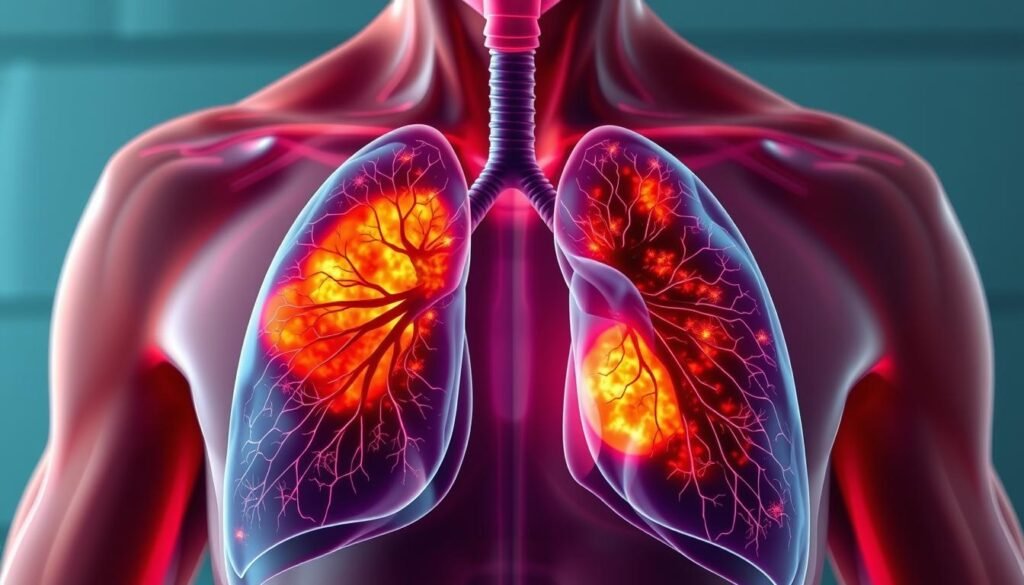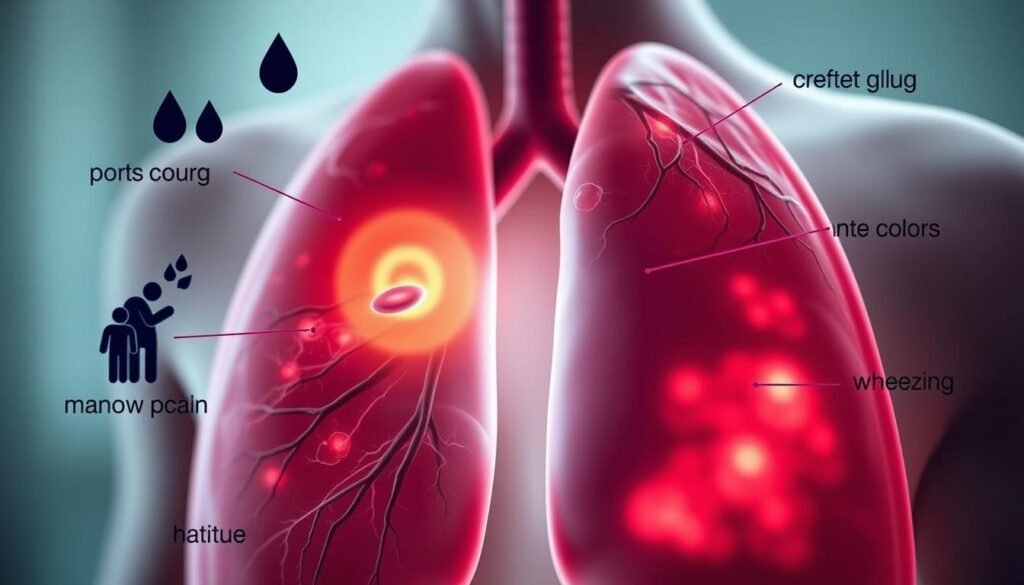About 35% of people with lung cancer find out they have it at stage 3. This fact stresses the need for knowing the symptoms of stage 3 lung cancer. Spotting these symptoms quickly is very important. It can lead to catching the disease early and getting the right treatments. These treatments can really help patients’ chances of getting better.
When lung cancer gets to stage 3, it spreads to nearby lymph nodes. This spreading can cause a variety of symptoms that affect how well someone lives. Knowing these symptoms means people can get help sooner. Next, we’ll talk about what symptoms to watch for. Spotting them early can make a big difference in treatment success.
Key Takeaways
- 35% of lung cancer patients are diagnosed at stage 3.
- Recognizing symptoms early can lead to effective treatment options.
- Symptoms may include persistent cough, chest pain, and weight loss.
- Stage 3 lung cancer may significantly impact a person’s quality of life.
- Timely medical intervention is critical for better prognosis for lung cancer.
Understanding Stage 3 Lung Cancer
Stage 3 lung cancer is known as locally advanced. It mainly stays in one lung and nearby lymph nodes and tissues. This stage is a crucial point in lung cancer’s progression. Around one-third of those diagnosed are at this stage. This fact shows its importance among small cell lung cancer stages.
The disease brings bigger challenges at this level. It can spread to different parts of the lung and nearby chest lymph nodes. This makes treatment more complex. For non-small cell lung cancer (NSCLC) patients, treatment and survival chances depend on health and cancer specifics. NSCLC makes up about 85% of lung cancer cases.
The 5-year survival rate for localized NSCLC is around 60%. But, it falls to 33% if the cancer spreads nearby.
Small cell lung cancer (SCLC) patients face tougher odds, with a 29% survival rate for localized cases. Reaching stage 3 means needing strict treatments. These can include surgery, chemotherapy, radiotherapy, and immunotherapy.
Survival rates have improved, offering hope. From 1989-1991, the survival rate was 13%. It went up to about 22% between 2011-2017. This rise highlights the impact of research and better treatments. It’s a big step forward for locally advanced lung cancer.
The Different Substages of Stage 3 Lung Cancer
It’s vital to understand the various substages of stage 3 lung cancer. These insights help in grasping how the disease advances. Moreover, they inform the choice of treatment. Stage 3 lung cancer has three substages: 3A, 3B, and 3C. They reflect the specifics of stage 3 lung cancer characteristics. Accurate staging uses the TNM (Tumor, Nodes, Metastasis) classification.
Stage 3A involves tumors that may grow up to 7 centimeters. Their spread is usually local, affecting nearby lymph nodes. This substage can touch various chest structures, like the mediastinum. Challenges unique to this stage affect treatment options. These may include both surgery and chemoradiation.
Stage 3B shows cancer reaching lymph nodes on the chest’s opposite side or above the collarbone. Treatment becomes more complicated here. It often includes a mix of chemotherapy and radiation. The involvement of more lymph nodes can lower survival rates. Early, precise diagnosis is thus critical.
Stage 3C represents a more aggressive spread. Cancer reaches multiple lymph nodes across the chest. This leads to harsher symptoms and complications. A multidisciplinary approach becomes crucial. Knowing these lung cancer subtypes helps doctors create patient-specific treatments.
| Substage | Tumor Size | Lymph Node Involvement | Treatment Options |
|---|---|---|---|
| 3A | ≤ 7 cm | Nearby lymph nodes | Surgery, Chemotherapy, Radiation |
| 3B | Any size | Opposite side or above collarbone | Chemotherapy, Radiation |
| 3C | Any size | Multiple lymph nodes in chest | Multidisciplinary Approach |
Knowing these substages is crucial. It helps not just in choosing treatments, but also in setting realistic expectations. It aids patients in coping. For more details, check out this informative piece.

Common Symptoms of Stage 3 Lung Cancer
Seeing signs of lung cancer early can help beat the disease. Stage 3 lung cancer has symptoms that are vital to know. This knowledge leads to faster treatment. A cough that won’t go away and chest pain are often the first warnings.
Many think these signs are from allergies or infections. It’s easy to mistake them for something less serious.
Loss of weight and appetite are also clues. When people don’t want to eat, they feel weak and tired. Both eating issues and breathing problems need a doctor’s check-up.
More symptoms show up as the cancer grows. These include feeling out of breath, very tired, and getting sick often. Recognizing these signs helps patients fight for their health.
Knowing the signs of stage 3 lung cancer leads to early help. It means better chances and encourages people to see a doctor fast.

Symptoms of Stage 3 Lung Cancer: What to Look For
It’s crucial to know the symptoms of Stage 3 lung cancer for early intervention. Patients often have different symptoms that vary in how serious they are. Knowing what to look for helps keep track of their health.
Persistent Cough and Chest Pain
One early sign of lung cancer is a cough that just won’t quit. Sometimes, the cough gets worse and includes coughing up blood. Chest pain can also happen because tumors block air passages and cause swelling. Paying attention to these signs is important as they can show major changes in health.
Unintentional Weight Loss and Loss of Appetite
If someone is losing weight without trying and eats less, it could mean their condition is getting worse. These signs often come from being very tired, which affects daily life and happiness. Not eating enough can lead to not getting the right nutrients, making treatment harder. So, it’s important to keep an eye on these symptoms.
Shortness of Breath and Fatigue
As lung cancer gets worse, it’s common for patients to feel short of breath. Doing things can make this even harder. They might also feel unusually tired. Noticing these signs is key to understanding the illness better and planning treatment.

Additional Symptoms Associated with Advanced Lung Cancer
Advanced lung cancer brings extra symptoms that can worsen a patient’s life. These signs often show the cancer spreading to other parts, like bones and the brain. Spotting these symptoms early helps manage them better, making life more comfortable.
Bone Pain and Neurological Symptoms
Bone pain is common when lung cancer reaches the bones. This kind of pain can be really bad, changing how well someone can move or do daily tasks.
Some people might also get neurological signs. This means the cancer could be affecting the spine. Symptoms include:
- Weakness or numbness in limbs
- Dizziness or loss of balance
- Confusion or changes in how the brain works
Catching these signs early is key to helping someone feel better.
Discomfort in the Chest Wall and Mediastinum
Chest pain is another sign of advanced lung cancer. The pain comes from cancer pushing on the chest wall and mediastinum. This can feel like:
- Pain that gets worse when breathing deeply or moving
- Pain that spreads to the shoulders or back
- A more sensitive chest area
This pain can make everyday life hard, leading to the need for good pain control methods.
How Is Stage 3 Lung Cancer Diagnosed?
The journey to diagnose stage 3 lung cancer begins with imaging for lung cancer. Doctors use chest X-rays and CT scans to look for lung issues. These tests are key to finding out if the disease is present. This is especially true for smokers who often get checked even without symptoms.
Yearly lung cancer checks are advised for those at high risk. Specifically, this means people 50 or older who have smoked a lot. Catching cancer early makes treatments more likely to work.
If imaging spots potential cancer, biopsy methods come next to confirm. Doctors may use needle biopsies or surgery to collect tissue samples. These help figure out the cancer’s type and stage.
Knowing the exact stage of cancer is critical for planning treatment. It helps doctors understand how far the cancer has spread. Diagnostic tests for lung cancer are vital. They guide doctors in treating the patient in the best way possible.
Lung Cancer Treatment Options for Stage 3 Patients
Patients with stage 3 lung cancer have several treatment choices. These are designed for their particular situation. Often, treatment includes a mix of therapies. Chemotherapy for lung cancer and radiation therapy are commonly used together. This approach helps control the tumor and manage symptoms.
Combination Therapies: Chemotherapy and Radiation
Chemotherapy for lung cancer often uses drugs like cisplatin and etoposide. They’re paired with radiation therapy. This combination increases treatment success. It can shrink tumors and better prepare patients for possible surgeries. Radiation might be the main option when surgery is too risky.
Personalized Treatment Plans: The Role of Clinical Trials
For those with advanced stage 3 lung cancer, clinical trials for small cell lung cancer offer new treatments. These trials target specific genes or introduce innovative therapies. Patients get treatment plans tailored to their health and the specifics of their cancer. This tailored approach greatly raises the odds of good results.
| Treatment Option | Description |
|---|---|
| Chemotherapy | Combination of drugs, often cisplatin with etoposide, to kill cancer cells. |
| Radiation Therapy | Used alone or with chemotherapy to control tumor growth. |
| Surgery | Limited to stage 3A; options include lobectomy or pneumonectomy after chemoradiation. |
| Immunotherapy | Utilizes immune system boosters such as PD-L1 inhibitors. |
| Clinical Trials | Access to innovative treatments and new drug combinations. |
This approach aims to enhance the quality of life and survival for patients. Exploring all options, including the latest therapies and clinical trials, can offer new ways to fight lung cancer.
Prognosis and Survival Rates for Stage 3 Lung Cancer
Understanding stage 3 lung cancer requires looking at different survival rates. About 15% of people diagnosed with this stage live for five or more years. These survival rates change based on the cancer type and personal health.
Non-small cell lung cancer (NSCLC) is the most common kind. About 37% of people with regional NSCLC survive for five years. Small cell lung cancer (SCLC) survival rates are lower, with only 18% living five years. This shows how survival can vary greatly.
Many factors affect how long someone with stage 3 lung cancer can live. Age, if someone smokes, and where the tumor is can all influence survival. Treatments like immunotherapy give hope for better survival rates.
Treatments are becoming more customized. Having a mix of treatments can lead to better results. Talking to doctors is key to finding the best plan for each patient.
Lung cancer survival rates are getting better with research. Spreading the word about treatment options can make a big difference in survival. For more info on survival rates, check out this article.
Conclusion
Knowing the signs of lung cancer is key for quick action. With lung cancer being very common and leading in cancer deaths in the US, spotting early signs is vital. Symptoms like a lasting cough, pain in the chest, or shoulder might mean it’s serious, like stage 3 lung cancer.
Talking to doctors about any worrying symptoms is important. This is especially true for those more likely to get lung cancer.
Also, support for lung cancer patients and their families is very important. Different treatments, from surgery to new therapies, are available. Having a good support system helps patients feel better and cope emotionally. And knowing that most lung cancers are the non-small cell type underlines why talking about symptoms is crucial.
In conclusion, continuing to raise awareness about lung cancer is key. Screenings are crucial, especially for those 50 to 80 who’ve smoked a lot. Staying informed can make a big difference in fighting lung cancer. Readers looking for more info on early signs should check out this detailed guide.